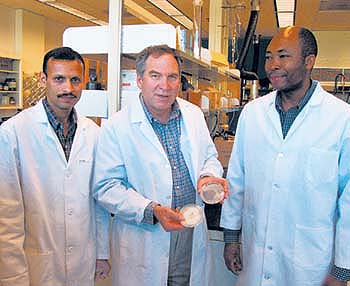All Issues
Science briefs: April-June 2003
Publication Information
California Agriculture 57(2):36-37.
Published April 01, 2003
PDF | Citation | Permissions
Full text
Pesticide-free produce may contain more antioxidants
Berries and corn that are culti-vated without pesticides contain a significantly greater amount of polyphenolic antioxidants than conventionally grown fruits and vegetables, UC Davis sc tists report. The marionberries (a type of blackberry), strawberries and corn researchers studied contained as much as 58% more polyphenolics.
The researchers, led by Alyson Mitchell, assistant professor of food science, found that the produce grown organically or sustainably — with fertilizers but without pesticides—measured higher levels of ascorbic acid, or vitamin C, as well.
The fruit and corn were grown in matched plots by a farm in Oregon, then were frozen, freeze-dried or air-dried before the nutrients were measured. Frozen sustainably grown and organic marionberries and corn contained 50 to 58 percent more polyphenolics than conventionally grown crops from neighboring plots. Sustainably grown frozen strawberries contained 19 percent more polyphenolics than conventional fruit. These levels were nutritionally significant.
While researchers know that a diet high in polyphenolics can reduce the risk of some cancers and heart disease, they aren't sure how. “We know they're beneficial, but we don't know what types of polyphenolics are beneficial, or in what quantities,” Mitchell said.
Mitchell hypothesized that crops grown without pesticides or herbicides might make more polyphenolics because they are more likely to be stressed by insects or other pests. Poly-phenolics are natural chemicals produced by plants as byproducts of other processes. When plants are stressed, they produce higher levels of the bittertasting polyphenolics and drive away pests.
Microorganisms break down toxic pesticide
UC Riverside scientists have isolated microorganisms that can break down endosulfan, a persistent insecticide used on crops around the globe. The microorganism strains can be added to soil or water to significantly reduce levels of the insecticide.
“We have been successful in isolating strains that can use endosulfan as a carbon and energy source,” said William Frankenberger, director of the UCR Center for Technology Development and professor of soil science at Riverside. He added that microorganisms will rapidly degrade pollutants when they are able to use them as an energy and carbon source.
Endosulfan, an organochloride in the same family of pesticides as DDT and dieldrin, has a half-life of 9 months to 6 years. Because it lingers so long, it can enter the food chain and cause damage to the central nervous system, kidneys, liver, blood and parathyroid gland. It can also cause birth defects and genetic mutations. The pesticide is registered for use on 60 crops in the United States and is found in waters in 38 states.
Frankenberger's findings indicate that the microorganism strains could be added to contaminated soils, bodies of water, insecticide waste dumps, wastewater and stockpiles of endosulfan. His research found that one strain, Fusarium ventricosum, was able to degrade about 90% of 100 ppm endosulfan within 15 days. Another strain, Pandoraea sp., degraded about 83% within 15 days.
The research was conducted at UC Riverside in 2001 and 2002 and published in the Journal of Environmental Quality.
Lake Tahoe clearest in a decade
Lake Tahoe's renowned blue waters were clearer last year than they've been in 10 years, UC Davis researchers said. The clarity of the lake is good news for scientists who have been trying to reduce Lake Tahoe pollutants for the past four decades.
“These are encouraging results, and we hope they indicate the beginning of the lake's recovery,” said Charles Goldman, director and founder of the UC Davis Tahoe Research Group. “However, 10 years is a short time, and it is too early to say if the recent improvements will continue. We must keep up our efforts to prevent water and air pollution, or we may still end up with a green lake.”
In 2002, a white disk lowered into the lake approximately once a week was visible down to an average of 78 feet. Those are the best results since 1992, when the average visibility depth was 78.3 feet. The lake still has a ways to go, however: In 1968, when researchers began measuring the clarity, the dinner-plate-size disk could be seen down to 102.4 feet.
Goldman noted that 2001 and 2002 received less rainfall than average, which reduced runoff and could have helped clarity. But efforts to improve the lake's clarity may have contributed. These include reducing the runoff of fine sediment, which makes the water cloudy; limiting nutrients such as fertilizers that promote algae growth, which makes the water green; and minimizing the air pollution that is deposited into the lake.
“Whether or not runoff was reduced by low precipitation or by improvement projects, or both, the lake may be showing that it can recover,” Goldman said.
UC Riverside researchers Tariq Siddique, William Frankenberger and Ben Okeke with samples of isolated purified bacterial and fungal strains that decompose endosulfan.
West Nile vaccine for horses
UC Davis equine experts recommend that horses be vaccinated in March and April this year for West Nile virus. Horses should receive two doses three to four weeks apart from a licensed veterinarian before the mosquito season begins.
Horse owners are advised to consult with their veterinarians for the vaccination of individual horses. Pregnant mares and foals less than one year, for example, should receive modified treatments.
West Nile virus is much more deadly in horses than in humans—one out of three horses infected will die from it. Signs of infection in horses vary markedly but can include twitching or flaccidity of the lips, listlessness, stumbling and lack of coordination, leg weakness and a tendency to startle easily.
The experts also encourage ranchers to eliminate standing water around horses to reduce mosquito populations and to stable horses during active mosquito feeding times—dawn and dusk.
The vaccine, manufactured by Fort Dodge Animal Health, a division of Wyeth Laboratories, in Overland Park, Kan., is named West Nile—Innovator. It has received unconditional approval from the U.S. Department of Agriculture and is available only from licensed veterinarians.






